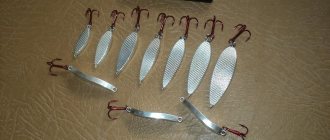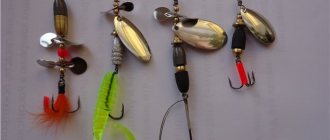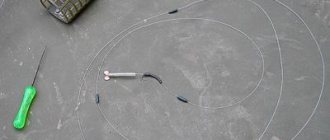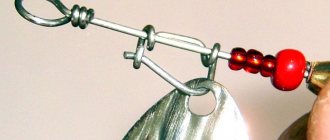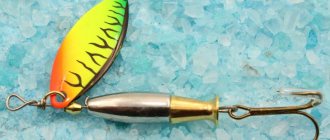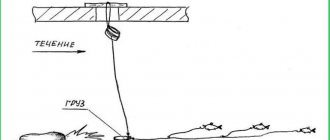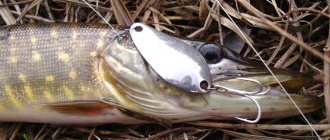Varieties of jigs
The goal of a good jig is to imitate the habits of natural prey. It precisely generates movements that should attract the target fish and make it bite. After the main contact, the angler pulls the jig up about 1 m, and then brings it back into the predator’s activity zone.
The second method of movement is to imitate prey swimming in the middle water layers of a reservoir. Most fish bite from top to bottom when the prey is in the diving phase. Accordingly, the jig imitates the action of a sick fish that swims down in a layer of water. As soon as the predator has bitten, the angler begins to pull on the fishing line.
An important feature of all jigs is that they are artificial fish that oscillate in the water column. On one side there is a loop so that the fisherman can secure the fishing line, and on the other there is a treble hook for bait. The length to width ratio is 6:1. Many models have a round, hexagonal, rectangular or square cross-section.
Important! For freshwater bodies of Russia, jigs weighing 15
–
40 g, and length – 7
–
8 cm.
Main types of jigs:
- In the shape of a fish (Renegade Iron Minnow). The bait perfectly imitates the behavior of fry. Available in three weights: 12g, 18g and 24g.
- Oblong with a weighted upper part (Kastmaster) - turns over in the water, which makes it more attractive and imitates small fish.
- A spoon in which the upper and lower parts are neatly cut off at an angle, like a tree branch ( homemade jig );
- Faceted jig (Sabunaev's three-edged jig) - its edges reflect sunlight, which attracts attention to the bait.
Jigs for sea fishing
For sea or lake fishing, various tackles and baits are used. One of them is jigs. Essentially, these are weighted spoons, which are more often used for sea fishing for catfish, flounder, cod, halibut, etc. Fishing is carried out from different types of vessels: boats, cutters, yachts or ships.
What is a jig and how to use it?
A traditional jig is an elongated, weighted metal block to which hooks are soldered. It is intended for deep-sea fishing and is more often used on the seas, although there are also species that are used for catching freshwater fish.
The jig is designed for deep-sea fishing and is more often used on the seas
There are two main techniques:
- fishing without casting - the process is carried out by lowering the tackle to the bottom over the side of the vessel;
- fishing with casting over long distances using different fishing techniques.
Fishing without casting
You need to purchase a jig, rod and reel suitable for this type of fishing. The rod must be strong, from 1.9 to 2.4 meters long and with special rollers. A multiplicative type inertial coil is also used.
This technique is mainly used at depths of 100–400 meters and is popular in Norway and Denmark.
When fishing, other factors are taken into account, such as wind strength and current speed. The technique itself consists of twitching the rod up and down. This should attract fish. For greater effect, they hook bait, which can be a sea worm or a small fish.
Casting fish
For this technique, fishing spots with shallower depths are selected. You can use elongated, heavy, round or flat spoons, with one or two treble hooks.
The hook, which is attached to the upper ring, can be baited with additional bait, which increases the chances of getting a catch.
Using two tees has its drawbacks. Hooks can get caught on an uneven bottom, and, accordingly, the risk of breaking the tackle doubles.
Additional bait can create a bite effect and provoke the fisherman into useless hooks.
The weight of jigs used for casting fishing is less than in the vertical deep-sea fishing technique. The ideal option is considered to be gear weighing 75–85 grams.
The fisherman makes a cast, and the line weakens when the spoon hits the water. After this, in order to feel the bait, the fishing line is pulled and retrieving is carried out using various methods.
How to make a jig with your own hands
Heavy spoons for sea fishing, intended for the use of the first technique, are quite expensive, and very often such a purchase is not justified. If you do it yourself, you won’t have to regret the money spent.
Metal tube jig
Metal tube jig
To make gear, you can use a piece of stainless steel or copper tube or a piece of metal rod.
In order to make a jig from a pipe, you will need the following:
- hacksaw for metal;
- drill and metal drill bit;
- lead (you can take an old battery);
- gas-burner;
- old tin can;
- fine-grained sandpaper;
- foil.
We decide on the length of the future gear and designate places for trimming. Use a hacksaw to cut off the edges at an angle of 45 degrees.
We disassemble the old battery and take out the lead plates from it, which we place in a tin can and heat with a gas burner.
You should take care of your own safety measures and attach some kind of handle to the tin can and handle lead carefully so as not to get burned.
When the lead turns into a liquid state, fill the metal tube with it. After the metal has hardened, take a drill and a metal drill bit and make two holes along the edges of the workpiece.
We insert the rings, after which we attach a tee to one of them. You need to make a notch in the middle of the jig so that the lead does not crawl out of the tube in cold water.
To do this, use the back of the hammer to make one blow to form a dent.
To make the jig more shiny, you can try polishing the surface of the pipe with sandpaper. If this does not give any effect, cover it with foil.
If a metal rod is used as a workpiece, all actions should be performed in the same way, but without using lead.
Cutlery jigs
Cutlery jig
DIY jigs for sea fishing can be made from cutlery of suitable shape and size.
After searching a little in the kitchen drawers, you can find some kind of knife, spoon or fork with a smooth handle. Such devices make good spinners for casting fish.
Having taken a suitable workpiece, we cut it with a hacksaw for metal. Remove uneven edges with a file and then polish with sandpaper. We drill holes with a drill, attach a hook and fishing line. The tackle is ready.
Jig from tweezers
Jig from tweezers
Oddly enough, this device can also be suitable for making spinners. Any electrical or radio repairman has it, and can also be lying around in the closet of any good owner.
The manufacturing process is practically no different from the previous one. We take tweezers and cut out a piece of the required length from one of its halves. We sand the sharp edges with a file and smooth the surface with sandpaper. Drill holes and attach hook and line.
As you can see, making tackle with the necessary tools and materials is quite easy. This requires minimal investment of money and time, which has an undeniable advantage compared to purchasing factory products. At the same time, the quality of homemade jigs is almost as good as those purchased in a store.
by HyperComments
Source: https://plotka.ru/pilkeryi-dlya-morskoy-ryibalki/
How to make your own bait
The simplest jig is a plastic tube with lead poured inside. A hook (on one side) and a loop (on the other) are soldered to it. Its main parameters should be the same as described above, including weight, size, color.
Another option is a spinner cast in the shape of a fish from lead. All industrial products without exception are manufactured in this way. The triangular model is made from a sheet of metal that is rolled into a triangle. Then they soldered the seam, poured lead inside, and soldered a hook and eyelet to it.
Did you know? Asps swim in a flock, in which the female dominates. If you manage to catch one, then there is a chance to catch a couple more fish there.
DIY jig: options for making it at home
Before starting to consider the main topic of the article, it is necessary to clarify what a jig (pilker) is.
What does it have to do with fishing? And is it really important that the jig is made with your own hands or purchased in a store? For those fishing enthusiasts who have never used this bait, it will be interesting to know that there is no more popular spoon bait in the northern seas. Halibut and cod, pollock and flounder are the main trophies of sea hunting using a jig or, in the local dialect, a punda.
Installation of the spinner
Assemble the spoon and fishing line as follows:
- The end, 15–30 cm long, is pulled through the loop for attaching the fishing line.
- Hold the lure in one hand (most people use the left) and wrap the end 4-6 times around the straight section of line that runs to the reel.
- Pass this end through a small loop at the eye of the spoon, and then pull it through the loop for attaching the fishing line.
- Tighten the knot by pulling the tip of the fishing line.

In order not to think about painting a homemade spoon, just wrap it in fish skin with scales, and it will not only imitate the natural production of asp, but also distribute a natural aroma.
How to catch asp with a jig
Asp (lat. Aspius) is a predatory fish that is found in many European rivers. Some individuals reach a weight of 12 kg and a length of 1.2 m. The predator is caught in the warm season in shallow water or in wide sections of the river. It is especially easy to obtain after spawning - at this time the fish becomes hungry and hunts for any prey.
Find out also how to deliciously cook asp in the oven.
Look for a fallen tree or the edge of a shallow, estuary, or waterfall. The asp loves places with fast currents. Please note that the bait will be carried away by the current, so equip it with an appropriate sinker.
For fishing take:
- jig weighing 4–6 g, thin, silver;
- fishing line with a cross-section of 0.1–0.15 mm.

The asp is a very active and violent fish. Therefore, you need to set up the coil correctly. Fish, keeping in mind the following rules:
- Cast as far as possible, downwind.
- If the wind is in your face and there is no way to change location, then you need a spoon weighing about 150 g, which will immediately sink quickly. Often the asp swims to the very bottom and only grabs the prey next to it.
- Periodically, smoothly raise and lower the lure at a distance of 1 m.
- Take pauses so that the bait appears on the surface and dives again. This technique imitates the behavior of small fish feeding on the surface of the water.
- When fishing in shallow water, cast the lure, and then pull it not from top to bottom, but towards the shore and back.
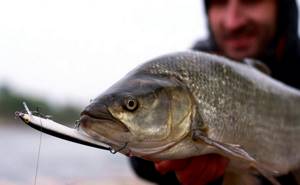
For successful fishing, stock up on several hooks (if the fish breaks) and several types of bait. If the asp does not want to peck at one, you can use another. If you get the hang of using bait correctly, this will increase your chances of successful fishing.
DIY jig for sea fishing
Their catchability was also in demand when fishing in reservoirs and rivers within the country.
The best examples of jigs for cod turned out to be no less popular among fans of fishing for pike perch, asp, pike and perch, both plumb and when jigging. Their size and shape have changed somewhat, but the equipment remains the same.
But the high cost of such spinners is increasingly forcing local fishermen to make jigs with their own hands.
First of all, it should be noted that the best jigs for sea fishing are heavy spoons for vertical lures. They can be classified according to several characteristic features:
- First of all, by weight. Based on this indicator, jigs are selected depending on the fishing conditions. Depending on the speed of the current, the depth of the bait and the wind speed, it can reach up to 700 and even 1000 g.
- According to its design features. They can be round, tubular, polyhedral and flat. Traditionally, homemade jigs for cod have an aspect ratio of 6:1. Moreover, their thickness correlates with width as 1:2 and, in some cases, as 1:1.
- According to the material of manufacture. These can be stainless or chrome-plated tubes filled with lead. Often there are samples made from profiled steel rods. When making homemade jigs for cod fishing, brass, cupronickel, copper and stainless steel are often used, with lead, sand and tungsten used to balance them.
Important! The cost of sea spinners of this type sometimes reaches up to 25 € per piece, and their life expectancy is no more than two or three hours. That is why the ability to make jigs for sea fishing with your own hands is not only tactical, but also purely economic.
Technical details of making jigs for sea fishing
According to most well-known sea fishing experts, the most catchy ones, in terms of design features, are triangular-shaped punds and flat samples with a wide end.
In addition, many cod hunting enthusiasts recommend equipping them with various rattles and glowing balls.
It is believed that reflective and light-accumulating stickers are good at activating fish bite in any conditions.
All these nuances are actively used by vertical lure experts when making saltwater jigs with their own hands.
A simple tool, affordable and sometimes waste material, and skillful hands leave no doubt that homemade jigs for cod are no worse than branded products in their catchability.
Only one of the popular companies produces various jigs over 40 tons. per year, without any problems with their implementation.
Home production of catchable jigs
Having produced several dozen good punds before the fishing season, you can be sure that the upcoming cod hunt will not cause much financial damage to its participant.
Moreover, no matter how diverse the range of marine spinners for vertical and jigging is, the most popular were and remain tubular samples with lead balancing.
They are also the most convenient for making at home.
The material costs for equipping such a home production are extremely small:
- Equipment. This is, first of all, an angle grinder, a miniature machine (in everyday slang - “grinder”) with a set of cutting and cleaning discs. Household sharpening machine with grinding and polishing wheels. A small screwdriver with a set of bits and drills.
- Devices and tools. Bench vice with jaws up to 125 mm. Gas canister with a burner for melting lead or babbitt. Mobile injection molds for casting replicas of spinners. Foundry ladle with wood-lined handle. Set of files, hammer and core.
- Materials. An assortment of any tubes from a wide variety of materials. They can be made of stainless steel, steel with a decorative or anti-corrosion coating, copper, brass or aluminum alloy AMG-6. Lead from old batteries or balancing weights from a tire shop. Babbitt from old plain bearings. Alabaster or gypsum for molding products in foundry molds.
Important! All of the listed components of home production are not unique. Moreover, almost all home craftsmen have them. All DIYers, without exception, can make a collapsible casting mold from chipboard or multilayer plywood. The source material for the punds is completely waste - old baby strollers, disrepaired faucets from kitchens and bathrooms.
Technology for making pipe jigs
This is one of the most popular and easiest to manufacture spinner models. The tube, beveled on both sides and the equipment attached to it, leaves no secrets for those who would like to know how to make a jig with their own hands. Some difficulties may arise when it is necessary to make a spinner with a weight differentiated by length or a rattle inside.
Source: https://ogorod.life/rybalka/pilker-dlya-morskoj-rybalki-svoimi-rukami.html


